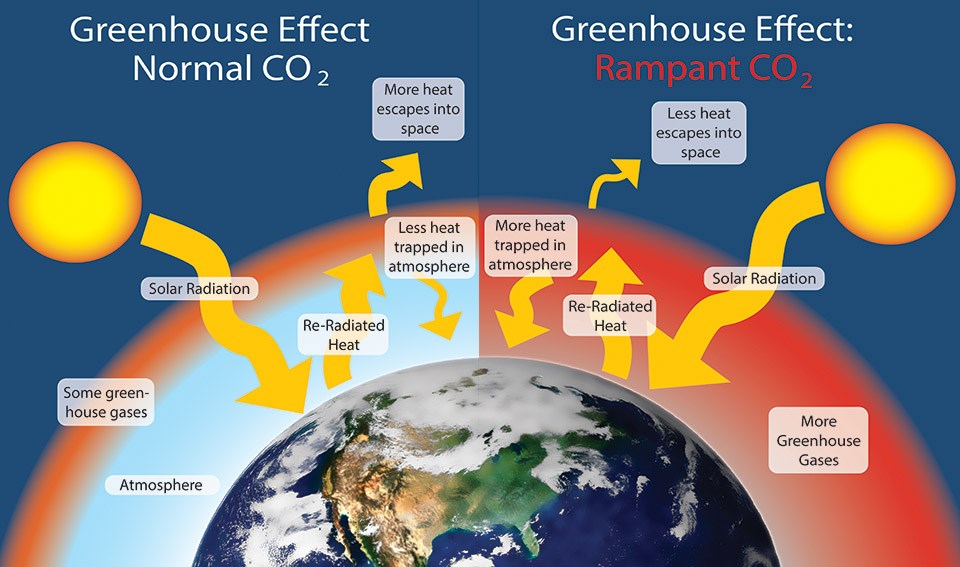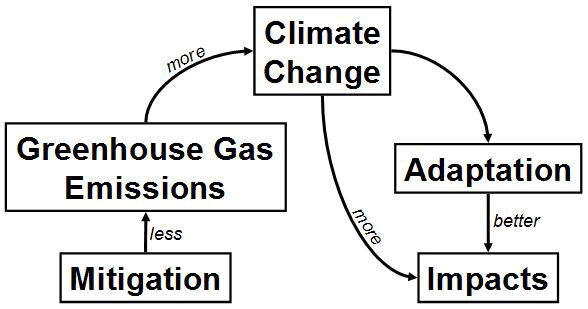59 The Physical Basis
The physical basis of climate change refers to our understanding of the physical properties of the climate and how it is changing. In other words, it is the physical (or natural) science behind climate change. Despite being a physical science, it asks some questions of major political and societal importance. Is the climate changing? In what ways is it changing? Are these changes caused by human activity? Because there is so much at stake with the answers to these questions, the physical science of climate change has been the center of extensive attention and a fair amount of controversy. In order to understand the human aspects of climate change, including the political issues, it is very helpful to have some understanding of the physical basis.
Climate vs. Weather
As a starting point for understanding climate change, we should recognize the difference between climate and weather. The difference is essentially a difference in scale. Climate refers to broad-scale trends in meteorological phenomena such as temperature, precipitation, and wind. Weather refers to local-scale instances of these same phenomena. Mark Twain once famously said: “Climate is what we expect, weather is what we get.” Climate patterns are identified by averaging the meteorological conditions over a long span of time (generally 30 years or more), allowing us to generalize what the weather conditions tend to look like for a given location and time of year. For instance, looking at the chart below from the Pennsylvania State Climatologist’s Office (link: Pennsylvania State Climatologist(link is external)), we know that average high temperatures in July for Harrisburg, PA tend to be in the mid-80s (F). However, depending on the weather conditions during a particular year, actual values of meteorological data can end up above or below a climatological average. During July 2020, for example, anomalously warm weather conditions led to an average high temperature of 92 degrees F – several degrees higher than the average conditions.

Understanding the distinction between climate and weather is crucial to developing a sound understanding of climate change. An isolated warm summer, by itself, is not necessarily evidence of climate change; rather, the departures from expected climate conditions for a particular year indicate climate variability, which do not necessarily demonstrate shifting trends in long-term climate. In contrast to climate variability, which corresponds to the standard “highs and lows” of the weather conditions for a given year, climate change refers to a shift in climate conditions over time. Although sporadic colder than average conditions have occurred recently, the observed shifts in overall climate conditions with time demonstrate a warming trend at the global scale, which is evidence of climate change.
Climate Change
Although changes in climate regimes have occurred numerous times throughout Earth’s history, a key distinction of modern (21st century) climate change is the impact of human activity on climate. In particular, emissions from industrial sectors are leading to an increase in the concentration of greenhouse gases in the lower atmosphere. The chemical composition of these greenhouse gases (e.g., carbon dioxide, methane) leads to absorption of surface radiation, ultimately increasing the amount of heat stored in the lower atmosphere. Over time, this net increase in global heat storage has led to rapid (climatologically-speaking) rates of warming. These human impacts on climate change are referred to as anthropogenic climate change. Although natural drivers of climate change do exist (e.g., the cycle of Earth’s axis position), these natural impacts by themselves would suggest little changes to Earth’s climate regime at the present, except perhaps for a minor cooling trend. Thus, given the current strong warming rate, anthropogenic sources are the clear main drivers of modern climate change.

Common Misconceptions Surrounding Climate Change
To further develop a strong understanding of climate change, it is crucial to identify and clarify common misconceptions surrounding the physical basis of climate change. First and foremost, there is strong consensus within the climate science community on 1) the reality of modern climate change and 2) the significant impact of human activity on modern climate change. There is little debate among climate scientists about the reality of anthropogenic climate change; rather, most of the “debate” within the atmospheric science community corresponds to other issues, such as how to best predict future climate regimes or which potential governmental responses would be most effective at reducing greenhouse gas emissions. With that said, let’s clarify a few common misconceptions about modern climate change.
- Climate change is a natural phenomenon. As mentioned previously, it is true that natural drivers exist which influence climate change. For instance, the three factors of Earth’s axial tilt, precession, and orbital eccentricity – known collectively as Milankovitch cycles – play major roles in determining ice age and interglacial periods. However, these natural drivers of climate change alone would not be expected to produce the climate change presently occurring. Thus, modern climate change is largely anthropogenically-driven.
- The effects of modern climate change are good for humanity. Key tenets of this argument include that increasing carbon dioxide concentration levels will allow for greater agricultural production, as plants feed off of carbon. However, although plant life has flourished in prehistoric times of high carbon dioxide concentrations, these concentrations are rising at a much faster rate today than in prehistoric times. Thus, plant life today does not have the ability to adapt to shifting climate regimes and gas concentrations in the same way that prehistoric plant life could adapt to much more gradual climate change. In fact, many scientists anticipate adverse effects of rapid climate change on agricultural outputs. Another argument for the positive impacts of climate change is that increasing global temperatures will benefit human populations in colder locations. However, the effects of climate change are neither steady over time or uniform globally; a rapid shift to a warmer climate regime over a period of decades can result in unprecedented seasonal temperature swings within a given year, which can be very detrimental to food production. Additionally, climate change has major implications on precipitation patterns, leading to more unpredictable flood and drought patterns.
- Not all parts of the world are experiencing climate change. It is true that the temperature and precipitation shifts associated with climate change are non-uniform globally, with areas such as the Arctic more likely to experience dramatic increases in average temperatures than the Southeast U.S., for example. Further, much more subdued warming trends – or even cooling trends – have been observed over some parts of the world, such as the North Atlantic Ocean. However, these trends do not refute the existence and seriousness of modern climate change; rather, these patterns are occurring because of the impacts of climate change at other locations. For instance, increasing meltwater from warming over Arctic ice caps may be changing ocean circulation patterns, leading to an isolated area of cooling over the North Atlantic (Rahmstorf et al. 2015).
- Why are major snowstorms still occurring in the Northeast if the climate is changing? In short, air is able to retain more moisture as temperatures increase. This phenomenon is displayed mathematically by the Clausius-Clapeyron relation, which meteorology students may be (or will soon become) familiar with. Thus, so long as the ambient temperature at a given location during a winter storm is still cold enough to support snowfall, a snowstorm might produce more snowfall than would be normally expected, as more moisture is being retained by the atmosphere in our warming climate.
The bottom line: the physical basis for climate science is complicated and an area of extensive research, but the existence of anthropogenic climate change is scientifically-proven fact. Further, the rate at which the climate is changing is unprecedented, creating substantial concern for what climate conditions could be even within the next few decades.
The Human Dimensions of Climate Change
The remainder of this module focuses on the human dimensions of climate change, in particular how humans are impacted by climate change and how humans are responding to climate change. There are two main ways in which humanity is responding to climate change: mitigation and adaptation. Mitigation refers to efforts to reduce the amount of climate change that will occur via reducing the amount of greenhouse gases in the atmosphere. Adaptation refers to efforts to improve the impacts of whatever climatic changes end up occurring. Exactly what is meant by an “improvement” to the impacts is an ethics question. Similarly, there are ethics questions in what mitigation efforts humanity should make.
The relationship between climate change, mitigation, and adaptation can be seen in a simple systems diagram:

As this diagram shows, mitigation causes less greenhouse gas emissions, while greenhouse gas emissions cause more climate change. Thus mitigation causes less climate change. Meanwhile, climate change causes more impacts. Climate change can also cause adaptation, which leads to better impacts.
Reference
Rahmstorf, S., J. E. Box, G. Feulner, M. E. Mann, A. Robinson, S. Rutherford, and E. J. Schaffernicht, 2015: Exceptional twentieth-century slowdown in Atlantic Ocean overturning circulation. Nat. Climate Change, 5, 475–480, Nature, Exceptional twentieth-century slowdown in Atlantic Ocean overturning circulation(link is external).

